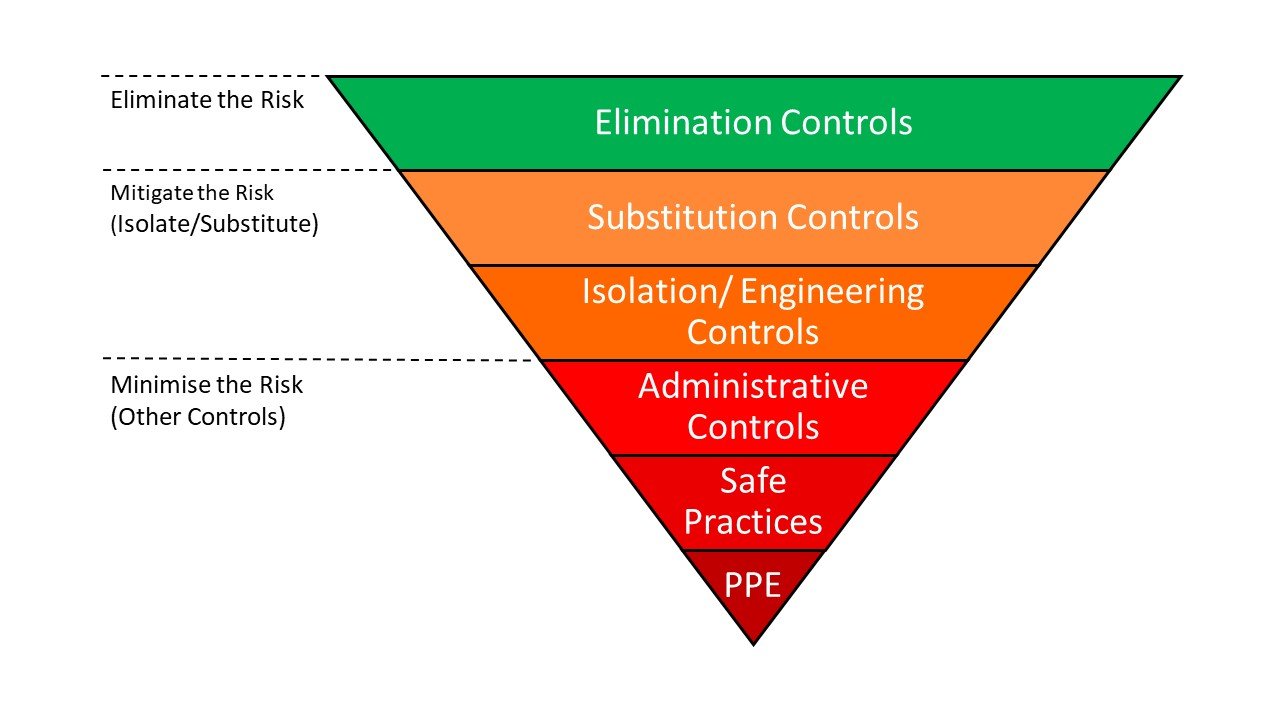Managing formaldehyde-based chemicals in mortuaries using the Hierarchy of Control
This article was published in the Funeral Care Magazine in the March 2023 edition
Formaldehyde, a chemical with a distinct, pungent and irritating odour, is well-known in the funeral industry and utilised in many embalming chemicals. If an embalmer or other worker is exposed there are risks of serious health impacts.
As a gas or vapour, formaldehyde can be inhaled; as a liquid, it can be absorbed through dermal (skin) contact. Since formaldehyde is a dermal sensitiser, this contact allergen causes irreversible change, so repeated exposure may invoke allergic contact dermatitis.
Exposure may cause drowsiness, fatigue, headaches, burning sensations in the eye, nose and throat, and respiratory difficulties. It can also pose health threats, such as oedema (tissue swelling), bronchitis, and pneumonia.
Formaldehyde is also carcinogenic and genotoxic (toxic to DNA). Studies of workers exposed show an increased rate of cancers, such as the very rare nasopharyngeal cancer, nasal cancer and myeloid leukaemia. Inhalation exposures also induce cytotoxicity by increased cellular replication in genetically compromised target cells.
Studies have revealed formaldehyde's genotoxic ability intensifies its carcinogenicity in nasal tissues.
Formaldehyde-based chemicals are heavily regulated in New Zealand. It is classified in the most toxic category of the toxicity classes.
A health and safety dilemma
The funeral industry is one of many sectors struggling with H&S responsibilities. These duties, obligations and liabilities can appear complicated and daunting. Employers are understandably fearful and anxious about the level of compliance and the related cost. These fears sometimes lead to frustration-based attitudes such as: the law protects the stupid employee; it's common sense; it takes a dumb worker to get hurt; it is simply a storm-in-a-teacup.
These beliefs are out of step with the current legislation and, sadly, risk harm to our people within this sector, which would in turn lead to increased scrutiny by WorkSafe. The tide can only be turned when employees and employers are engaged in a robust H&S culture.
I have worked with and for the funeral sector as an employee, a health and safety specialist, a business consultant, and a compliance certifier. The industry is known for its amazing service and support for families in times of need. Yet, there is a lack of H&S understanding related to general or specialised legislative requirements, the cornerstones in ensuring our people's ongoing health and well-being. As discussed earlier, formaldehyde-based chemicals are heavily regulated and classified as acutely toxic, ensuring some of the highest levels of regulatory control when managing formaldehyde-based chemicals.
The legislative landscape
The following laws and regulations apply: the Health and Safety at Work Act 2015, the General Risk and Workplace Management Regulations 2016, and the Hazardous Substances Regulations 2017. Environmental Protection Agency notices also apply.
These put the New Zealand workplace legislation in line with other developed nations. The act’s purpose was to provide a balanced framework to secure robust H&S in workplaces, protect workers and others from harm, understand and eliminate or minimise workplace risks, and to provide a fair and effective workplace representation, consultation, cooperation, and resolution of issues.
WorkSafe, as the regulator, has the power and authority to determine the “responsible parties” (employer or employee) and enforce the law using improvement notices, directive letters, fines and other penalties.
After internal reviews, WorkSafe is undertaking a shakeup in hazardous substance workplaces. WorkSafe said last year "there would be a clampdown on businesses flouting safety standards for hazardous substances", and these businesses may "get fewer second chances".
Hierarchy of control for mortuaries
The hierarchy of control is a system for assessing and managing risks in the workplace. It is a defined, step-by-step approach to eliminating or mitigating risks. It prioritises risk controls, starting from the highest level of protection and reliability.
When determing risk and the appropriate control measures exposure monitoring is often required. Regularly evaluating mortuary air quality is a legal requirement. This determines the level of chemicals in the air. Once the potential exposure is understood, the hierarchy of control is applied to manage the associated risks and reduce potential harm.
Source: Sabbath Consulting Health and Safety Manuals
The formaldehyde-based embalming chemicals should be the first to be removed from the workplace. Consider the following questions:
Are there embalming chemicals that you no longer use, are you storing more embalming chemicals than needed, and do you actively manage your inventory?
If the embalming chemical is necessary, you must reduce the risks. Consider the following: Can the chemical be substituted with a lesser-risk substance, can the hazard be isolated to reduce the number of people encountering it, and can engineering control be applied to minimise risks (physical barriers or improved ventilation)?
In addition to the above processes of elimination and mitigation, you should aim to further minimise formaldehyde-related risks through: administrative controls (ensure that there are standardised processes, safe practices (train and support those involved in handling, transporting, or disposing), and personal protective equipment (conduct a review based on the worker's exposure levels and determine the required protection level).
PPE by itself is not considered a control. In 2021, WorkSafe stated that "businesses shouldn't rely on respiratory protection equipment as the main way to look after the health of their workers. They need to consider the hierarchy of controls." After a WorkSafe investigation, a fine of $250,000 was imposed on a business for failing to prevent workers from being exposed to methyl bromide (a toxic chemical).
Jeshurun Chandra is a compliance certifier and Managing Director for Sabbath Consulting and Sabbath Training. She has extensive work experience in Canada and New Zealand, managing sites engaged in chemical-related operations and high-risk facilities. Sabbath Consulting has created a Formaldehyde Information sheet as a training tool and a self-assessment tool using the Hierarchy of Control to support Formaldehyde management.


